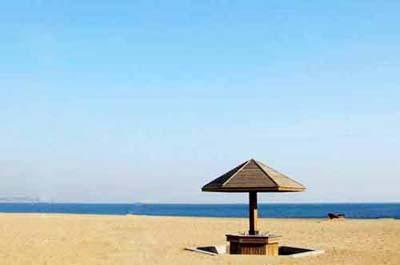 Dalian,
compared to ancient capital cities such as Beijing, Xian, Nanjing or
Luoyang, is a young city with only a 100-year history. Situated at
the tip of China's Liaodong Peninsular, it is a trading and
financial center in northeastern Asia and has gained the name the
'Hong Kong of Northern China'. Dalian,
compared to ancient capital cities such as Beijing, Xian, Nanjing or
Luoyang, is a young city with only a 100-year history. Situated at
the tip of China's Liaodong Peninsular, it is a trading and
financial center in northeastern Asia and has gained the name the
'Hong Kong of Northern China'.
The old name of Dalian was first used by an official in his memorial
to Emperor Guangxu in the Qing Dynasty (1644-1911) referring to the
present Dalian Gulf. In the early 20th century, the gulf area
developed quickly and Dalian expanded into a city of significant
size and importance.
After the Opium War in 1840, Dalian was plunged into warfare. At the
end of the 1800s, Japanese and Russian invaders successively set
their feet on the Chinese mainland here. In 1894, Japan invaded the
Peninsular and in 1897 Russian troops occupied Lushun Port (Port
Arthur) and imposed upon the Qing government an unfair contract, in
which they ceded Lushun as a colony to Russia. Seven years later,
Lushun was again transferred to Japanese rule, when the Russians
lost in the Japanese-Russian War. From then on Dalian suffered from
the colonial rule of Russia and Japan for decades. It was as
recently as 1955 that the Chinese government took over sovereignty
of Lushun and the hardest times in this city's history ended.
Both the Russian and Japanese colonists dreamed of establishing a
city of their own on this land in those colonial periods. A group of
Russian architects fascinated with French culture came to Dalian
with their construction blueprint of Paris and built all sorts of
elegant squares with artistic sculptures, lush lawns and
western-style fountains. These formed the architectural basis of the
present city - taking squares as the center and radiating outwards.
Today, the stylish women troopers patrolling the squares have become
a feature of the city.
Zhongshan District, originally the colonial residential area of the
Russians and containing Nicholas Square, (Zhongshan Square) is a
bustling downtown area of the city. The square (Zhongshan Square)
has ten avenues radiating from it and is one of the most famous
squares in the city. Renmin Square, originally called Stalin Square
and marked out to be the administrative center of the Russian
colonists, now houses the government's financial institutions in
Euro-style buildings. The old tramlines built by Japanese colonists
and left behind through the ages tell the history of the city.
The impression Dalian gives to the world is of a city of lawns,
squares, fountains and gardens. This is all thanks to the former
mayor of the city, Bo Xilai, who initiated a 'Green Storm' - a
widespread environmental campaign which brought numerous green
squares, forest parks and seaside scenic spots to the city. Of
Dalian, people say it is 'A City Built in Gardens'.
There are two things that have earned the city a great reputation.
One is Football and the other is Fashion. Given the name of
'Oriental Brazil', it hosts many Chinese football matches and has
the most successful football teams in China. The enthusiastic fans
in the football club of the four-star Wanda International Hotel tell
everyone how much the Chinese like this game.
Another carnival event in the city is Dalian International Fashion
Festival, during which thousands of dazzling celebrities, designers,
pop stars and clothing merchants from both home and abroad get
together to present an In-Fashion feast to the world. Consequently,
Dalian stirs shopping lovers' blood with all sorts of skyscraper
shopping malls and markets.If you are lucky enough to come to the
city around September, a sea of world-class fashion brands will
delight you.
Running from downtown Dalian there is a 40-kilometer (25-mile) road
known as Binhai Lu winding along the coastline, northeast to
southwest. This coastal area is a paradise for beach vacationers.
The famous scenic spots of Bangchuidao Scenic Area, Laohutan Scenic
Area, Jinshitan Scenic Area and Xinghai Square are scattered around
this region. In addition to the stunning cliffs and scenic parks,
numerous places along the coastline are good for beach resort
visitors and water sports lovers. Meanwhile, you can sample the
authentic Dalian-style seafood in a fisherman's house at an
incredibly low price.
Located to the southwest of Dalian is Lushun, the former military
and strategic port colonized by Russia. Today it is a place with
museums and historical sites for tourists to learn the history of
the city. Bingyu Valley, 240 kilometers (150 miles) north of Dalian
is home to an astonishing array of rock formations amidst limpid
waters, similar to those found in Guilin.
Surrounded by the Yellow Sea and inland Bohai Sea, Dalian has rich
marine resources. The seafood in Dalian is equal to its southern
counterpart in Guangzhong Province and there are numerous
restaurants in the city providing a wide variety of top-quality
seafood at very reasonable prices.
Numerous bathing places and beaches in the city are popular venues
for Dalian's locals to relax from everyday work and stress. Young
people, like those in many other metropolitan cities in China are
trend pursuers who spend their evenings in bars and pubs throughout
the city.
Dalian tourist attractions:
Dalian-Bangchuidao-Scenic-Area Dalian-Jinshitan-Scenic-Area Dalian-Laohutan-Ocean-Park Dalian-Lushun
Dalian-Bathing-Paradise Dalian-Bingyu-Valley-Scenic-Area Dalian-Squares-in-Dalian Dalian-Xinghai-Park
|

